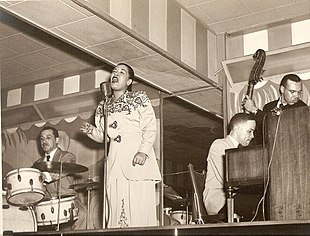
Rhythm and Blues (Continued)

Billie Holiday
On June 25, 1949, Billboard introduced the music category, "rhythm blues." However, it still encompassed boogie-woogie, urban, and doo-wop styles-or Black-sounding music. Nevertheless, it was a stylistically identifiable term for African American music, and because the other terms (e.g. Harlem Hit Parade) don't even refer to musical characteristics, it was not just a market-driven term. As time progressed, the term "rhythm and blues" slowly became more valuable to industry executives as a market-driven term. As seen in the list below, which catalogs the terms used to identify Black-sounding music from 1942 to 2005 beginning with the Harlem Hit Parade in 1942, "rhythm and blues" went through several different identifiers. In particular, the terms Hot Soul, Hot Black, and its reinstitution of Hot R & B in 1990 will be the focus of this lesson.
| "RHYTHM & BLUES" IDENTIFIERS | DATES |
|---|---|
| Harlem Hit Parade | 1942 to February 10, 1945 |
| Juke Box Race Records | February 17, 1945, to June 17, 1957 |
| Billboard's "Best Sellers" | May 22, 1948, to October 13, 1958 |
| Juke Box Race Records | February 17, 1945, to June 17, 1957 |
| Rhythm & Blues | June 25, 1949, to November 23, 1963 |
| Billboard's "Jockeys" | January 22, 1955, to October 13, 1958 |
| Hot R & B | October 20, 1958, to November 23, 1963; reinstated January 30, 1965, and continued under that name until the week ending August 16, 1969 |
| Best Selling Soul Singles | August 23, 1969, to July 7, 1973 |
| Hot Soul Singles | July 14, 1973, to June 19, 1982 |
| Hot Black Singles | June 26, 1982, to October 1990 |
| Hot R & B Singles | October 1990 to January 1999 |
| Hot R & B Singles & Tracks | January 1999 to December 1999 |
| Hot R & B/Hip-Hop Singles & Tracks | December 1999 to April 2005 |
| Hot R & B/Hip-Hop Songs | April 2005 to present |
The list above shows that the term "rhythm and blues" did not exist from 1969 to 1990-slightly over twenty-one years. Instead, the terms Soul (or Hot Soul) and Black (or Hot Black) identified Black-sounding music. The industry did not use or make reference to "rhythm and blues "again until October 1990. It is this author's opinion the reason for this is due to Billboard making an effort to flow with the current times in using ethnicity identifiers, such as soul and Black, as expressed by African Americans themselves.
This lesson will now turn to various types of music lumped into the rhythm and blues category after 1969, describe them, and discuss whether the terms are useful and descriptive or purely market driven. Since we already discussed rhythm and blues in lesson 19 and soul music through the 1960s in lesson 20, we will begin with a discussion of soul music in the 1970s. Our discussion of soul music in lesson 20 did not go further than the end of the 1960s, and the definitive music characteristics and performance practices then were not as prevalent in the soul music of the 1970s. In the 1970s, soul music changed or evolved, reflecting the post-civil rights environment. Moreover, the changes in soul music resulted from borrowing music features from contemporary music styles, namely funk and disco, as we will see.

Eddie Jones (Guitar Slim) best known for the song The Things That I Used to Do (1953)





